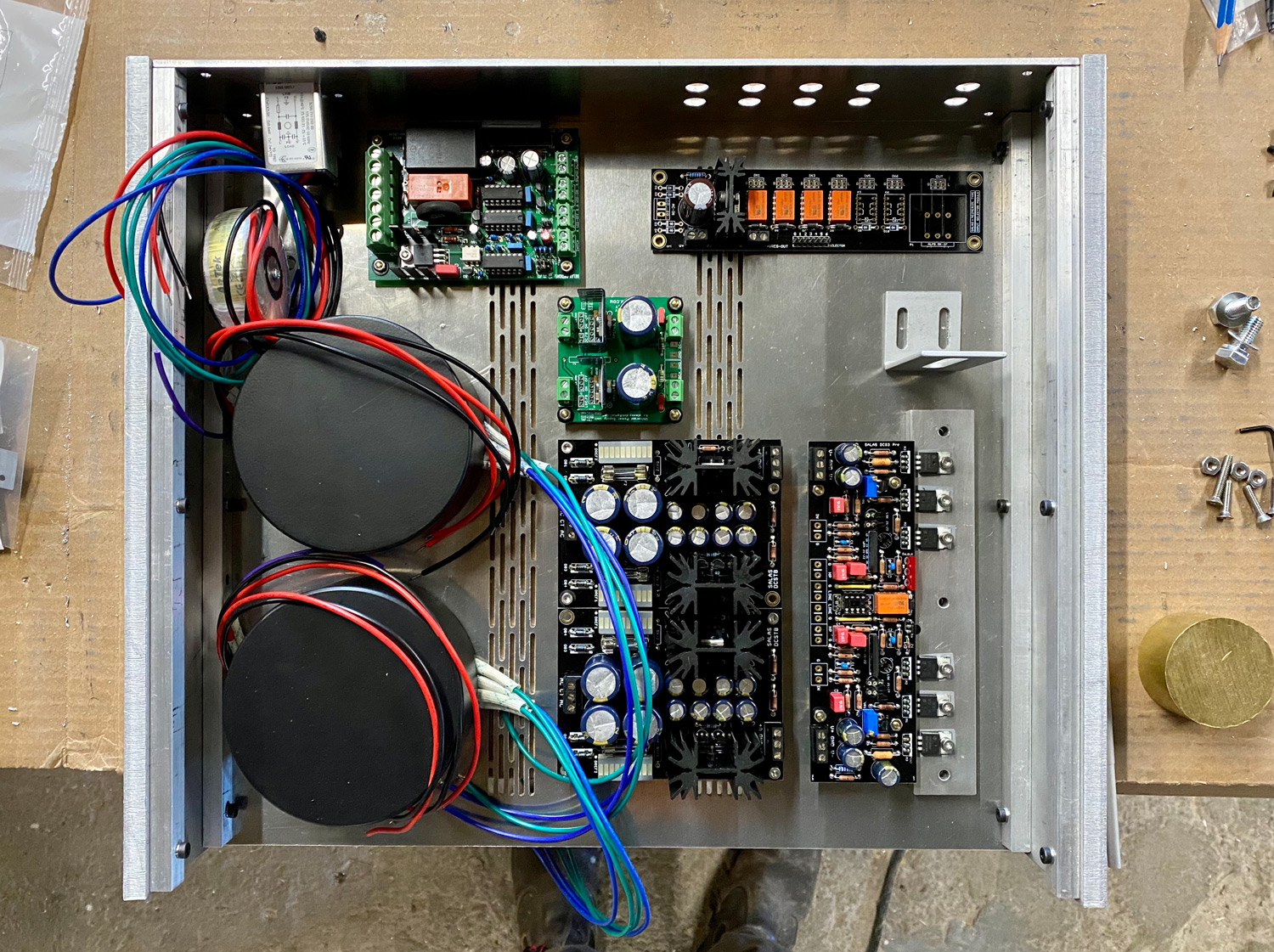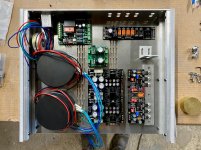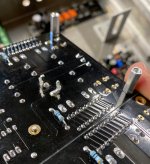Salas, for SE to BAL conversion I'm debating between a transformer or something like the below:
Universal Buffer – Neurochrome
What type of transformers did your friend use for the conversion? Given the characteristics of the DCG3 do you think one approach would work better than the other?
I primarily plan to use it convert my SE turntable to balanced as my amp is balanced.
Universal Buffer – Neurochrome
What type of transformers did your friend use for the conversion? Given the characteristics of the DCG3 do you think one approach would work better than the other?
I primarily plan to use it convert my SE turntable to balanced as my amp is balanced.
Start with 3X. It seems to work nicely at a friend's balanced DCG3 for various types of RCA and XLR source gear he uses. You will see if you have any need for more in your own system. SE to BAL 1:1 input transformer is going to bring SE at same level to BAL anyway.
I use Jensen JT11P1 for SE to Bal. Very pleased with them. If the distance between your two units is not much you can solder in a RCA SE at one end of the transformer wires and an XLR at the other end. You are essentially using the JT11P1 as an input transformer to the DCG3b.
nash
nash
fuse question
I just ran the electrical test and offset measurements on my DCG3 with DCSTB and I-select. Everything was textbook. All V ins to the DCG3 were 17V +/- .05,
R10's yielded 108mA and offsets were drifting about at around .5mA.
DCSTB is the mono version for each channel and used the group buy 250mA fst.
Decided to let it cook overnight for a recheck in morning. Did recheck and noticed I lost the +V on right side. DCSTB diode set was not lit and everything indicated open circuit. I pulled the DCSTB board thinking I might have a solder problem or part problem but only thing I could find was the fuse which was blown.
I do not know what caused the blown fuse but certainly could have been me.
So the question is, for reliability, is it a bad idea to use Slo blow version of the 250mA fuse. I certainly don't want to risk something on the DCG3. Not a huge deal and trying to learn.
Thanks,
Don
I just ran the electrical test and offset measurements on my DCG3 with DCSTB and I-select. Everything was textbook. All V ins to the DCG3 were 17V +/- .05,
R10's yielded 108mA and offsets were drifting about at around .5mA.
DCSTB is the mono version for each channel and used the group buy 250mA fst.
Decided to let it cook overnight for a recheck in morning. Did recheck and noticed I lost the +V on right side. DCSTB diode set was not lit and everything indicated open circuit. I pulled the DCSTB board thinking I might have a solder problem or part problem but only thing I could find was the fuse which was blown.
I do not know what caused the blown fuse but certainly could have been me.
So the question is, for reliability, is it a bad idea to use Slo blow version of the 250mA fuse. I certainly don't want to risk something on the DCG3. Not a huge deal and trying to learn.
Thanks,
Don
I do not know what caused the blown fuse but certainly could have been me.
If its a 250mA fast fuse indeed, the wire inside most probably went hot overnight due to lower spec. The preamp is Class A pulling nearly half that current rating constantly. Including its subsystems. Some fuse samples may hold, some they may fail.
The kits from Tea are just awesome (plus he made a nice little build guide I found someplace). T400mA fuses included. Anyway—some progress on mine...few more holes to drill and I'll test the PSU.
Also—plan to pull DC for In-select from one V+ 2200 cap per Salas recommendation someplace in this thread!

Also—plan to pull DC for In-select from one V+ 2200 cap per Salas recommendation someplace in this thread!
Attachments
Last edited:
Salas:
Im about to do some, hopefully upgrades, on my Dcg-3. Im Planning on changing psu from DCSTB to double U-bibs and upas to 2sk170 (mA matched).
Is there something I should take notice when doing these changes ( I havent built the ubibs yet, so changes for example parts are easily done)?
I ordered Quasimido board so I can learn how to implement snubbers and I also am learning how to use Rigol scope.
I have been extremely pleased for this pre. In fact, it was easily better than Tom Ewans The Vibe SRX This tells something about its potential.
This tells something about its potential.
Im about to do some, hopefully upgrades, on my Dcg-3. Im Planning on changing psu from DCSTB to double U-bibs and upas to 2sk170 (mA matched).
Is there something I should take notice when doing these changes ( I havent built the ubibs yet, so changes for example parts are easily done)?
I ordered Quasimido board so I can learn how to implement snubbers and I also am learning how to use Rigol scope.
I have been extremely pleased for this pre. In fact, it was easily better than Tom Ewans The Vibe SRX
Salas:
Im about to do some, hopefully upgrades, on my Dcg-3. Im Planning on changing psu from DCSTB to double U-bibs and upas to 2sk170 (mA matched).
Is there something I should take notice when doing these changes ( I havent built the ubibs yet, so changes for example parts are easily done)?
I ordered Quasimido board so I can learn how to implement snubbers and I also am learning how to use Rigol scope.
I have been extremely pleased for this pre. In fact, it was easily better than Tom Ewans The Vibe SRXThis tells something about its potential.
When changing to 2sk170, readjust offset by taking out the AD817 and using the trimmer to zero DC offset. Then put back the opa.
The kits from Tea are just awesome (plus he made a nice little build guide I found someplace). T400mA fuses included. Anyway—some progress on mine...few more holes to drill and I'll test the PSU.
Also—plan to pull DC for In-select from one V+ 2200 cap per Salas recommendation someplace in this thread!
Congratulations for your progress. Looking good so far. What are the extra green boards for?
Salas:
Im about to do some, hopefully upgrades, on my Dcg-3. Im Planning on changing psu from DCSTB to double U-bibs and upas to 2sk170 (mA matched).
Is there something I should take notice when doing these changes ( I havent built the ubibs yet, so changes for example parts are easily done)?
I ordered Quasimido board so I can learn how to implement snubbers and I also am learning how to use Rigol scope.
I would advise to perform those changes one step at a time. For better subjective evaluation of what promotes your hi-fi system's synergy and in what way. Such changes are reversible anyway. In other words the 2SK170s first, the supplies next.
JFET types are easy to replace. Just take notice of the 1D 1G 1S & 2S 2G 2D silkscreen marks for the uPA68 and put in the 2SK170s with their pins correctly. They should end up facing front to back between them in each pair.
2SK170s have higher transconductance and capacitance than uPA68, 2SK117, 2SK209 (SMD) which are comparable in spec between them. Thus K170s will differentiate the sound more than between those. Because the preamp's open loop gain changes more as a result. I have tested the pre for retaining stability with all mentioned input JFET options and more.
When changing to 2sk170, readjust offset by taking out the AD817 and using the trimmer to zero DC offset. Then put back the opa.
Its AD823 actually. After recently listening with OPA1656, OPA2156, OPA1642 on SMD adapter boards for a taste of what happens with those hi-tec modern op-amps I must still commend the BOM's AD823 for a very well balanced result between lows mids and highs for DC servo function in this particular circuit. It was a carefully investigated choice of the original design. The preamp's total projection and stage remain well proportioned with the JFET input AD823. Bipolar input op-amps are not suitable in this.
What the new generation OPAs bring to the table is their much lower self noise spec, extra output drive current, internal forward error correction minuscule THD, some with also higher speed and/or bandwidth. What can be traced in the end result is a cleaner background and a tighter leaner rendering of notes. More monitor less personal than with the AD823. With the JFET input OPA1642 bass and treble attain more contrast than with the CMOS process FET input OPA1656, 2156 which seem less initially impressive but more coherent across the audio band. A lighter clean sense. Depending on source equipment and speakers the synergy with OPA1642 in the servo system may end up bit tiring also.
What I would like best for a DCG3's servo chip? A fictional AD823 with the noise spec of the new OPAs.
I have been extremely pleased for this pre. In fact, it was easily better than Tom Ewans The Vibe SRXThis tells something about its potential.
I came across a friend's Tom Evans phono stage not too long ago. To restore original gain settings which have been altered for the cartridge of its previous owner. It had their Lithos regulator piggy back on a main circuit board of op-amps with rubbed off markings, and very many tantalum caps. Sandwiched together against a raw copper board shield, using sticky nylon stand offs, difficult to service. This company generally enjoys a good reputation I have seen. Quite pricey for the construction materials, plexiglass cases and all, but at least follows its own distinct design path in and out. Kind of what Darth Vader would have done to a DNM preamp.
Congratulations for your progress. Looking good so far. What are the extra green boards for?
Green boards:
—Power management, pwr switch control, LEDs, 5V for the Muses display
—Muses bipolar supply. Trying this out as a standalone to see if I can hear anything. I put a Muses controller in my Aikido and it was a marked improvement over the TKD. I powered it off one of the heater supplies via a tiny SMPS to get +/-15V...which is supposedly a little rogue. It worked just fine—and now we can remote control the volume with an old Apple remote. Slick.
Planning a slightly different Muses implementation by another member here that has a bunch of features and a small round OLED display.
Any reason to not use Mark's power management board? The inrush is totally overkill and likely not needed—but would it hurt anything?
I used Marks power management board in my DCSTB/DCG3 and all the voltages were perfect. I have not yet got to the In-Select signal portion of the pre however. I use it on every box I want to turn on and off. I am pretty nieve about this stuff so take this with a grain of salt. I haven't seen anything ugly yet but I may not be good enough to know. Put it on Salas' UFSP Phono also.
Put it on Salas' UFSP Phono also.
Don
Don
What I would like best for a DCG3's servo chip? A fictional AD823 with the noise spec of the new OPAs.
I would like a more 'meatier' opa sound, little bit like OPA627 (2 channel of course) with UBIB. With BIB and DCSTB it's another story. Probably I'd have adjusted/changed my DAC accordingly.
With good circuits it comes down to synergy in the end mainly because we all have different taste.
Last edited:
- Home
- Source & Line
- Analog Line Level
- Salas DCG3 preamp (line & headphone)

